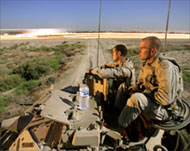US planning four more years in Iraq
The US Army is planning for the possibility of keeping the current number of soldiers in Iraq – well over 100,000 – for four more years, the Army’s top general said.

According to an Associated Press interview on Saturday, General Peter Schoomaker said the Army is prepared for the “worst case” in terms of the required level of troops in Iraq.
He said the number could be adjusted lower, if called for, by slowing the force rotation or by shortening tours for soldiers.
Schoomaker said commanders in Iraq and others will decide how many troops will be needed next year and beyond. His responsibility is to provide them, trained and equipped.
About 138,000 US troops, including about 25,000 Marines, are now in Iraq. “We are now into ’07-‘09 in our planning,” Schoomaker said, having completed work on the set of combat and support units that will be rotated into Iraq over the coming year for 12-month tours of duty.
Schoomaker’s comments come amid indications from officials of President George Bush’s administration and from commanders in Iraq that the size of the US force may be scaled back next year if certain conditions are achieved.
Conditions
Among those conditions: an Iraqi constitution must be drafted in coming days; it must be approved in a national referendum; and elections must be held for a new government under that charter.
 |
|
Reservists account for about |
Schoomaker, who spoke aboard an army jet on the trip back to Washington from Kansas City, Missouri, made no predictions about the pace of political progress in Iraq.
But he said he was confident the army could continue to provide the current number of forces in Iraq for many more years.
He was in Kansas City for a dinner on Friday hosted by the Military Order of the World Wars, a veterans’ organisation. “We’re staying 18 months to two years ahead of ourselves” in planning which active-duty and National Guard and Reserve units will be provided to meet the commanders’ needs, Schoomaker said in the interview.
Change in rotations
The Army has changed the way it arranges troop rotations.
Instead of sending a full complement of replacement forces each 12-month cycle, it is stretching out the rotation over two years.
The current rotation, for 2005-07, will overlap with the 2006-08 replacements. Beyond that, the Army is piecing together the plan for the 2007-09 switch, Schoomaker said.
With the recent deployments of National Guard brigades from Georgia and Pennsylvania, the National Guard has seven combat brigades in Iraq – the most of the entire war – plus thousands of support troops.
Along with the Army Reserve and Marine Reserve, they account for about 40% of the total US forces in Iraq. Schoomaker said that will be scaled back next year to about 25% as newly expanded active-duty divisions such as the 101st Airborne enter the rotation.
No risk
August has been the deadliest month of the war for the National Guard and Reserve, with at least 42 fatalities thus far.
|
“I can promise you that we’re not taking any risk in terms of what we’re doing to prepare people” |
Schoomaker disputed the suggestion by some that the Guard and Reserve units are not fully prepared for the hostile environment of Iraq.
“I’m very confident that there is no difference in the preparation” of active-duty soldiers and the reservists, who normally train one weekend a month and two weeks each summer, unless they are mobilized. Once called to active duty, they go through the same training as active-duty units.
In internal surveys, some in the reserve forces have indicated to army leaders that they think they are spending too much time in pre-deployment training, not too little, Schoomaker said.
“Consistently, what we’ve been (hearing) is, ‘We’re better than you think we are, and we could do this faster,”‘ he said. “I can promise you that we’re not taking any risk in terms of what we’re doing to prepare people.”